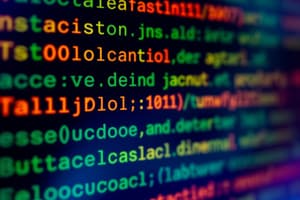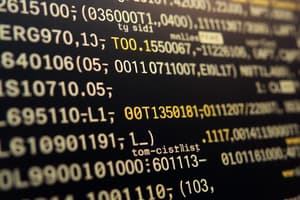Podcast
Questions and Answers
What are the two main types of language that the computer uses?
What are the two main types of language that the computer uses?
Machine language and assembly language.
What is the main purpose of assembly language?
What is the main purpose of assembly language?
Assembly language uses symbols to represent instructions, making it slightly easier to understand than machine language.
What is the role of the Assembler in programming?
What is the role of the Assembler in programming?
The Assembler is a program that converts instructions written in assembly language into machine language.
What are the benefits of assembly language compared to machine language?
What are the benefits of assembly language compared to machine language?
What is a pseudo-instruction used for in assembly language?
What is a pseudo-instruction used for in assembly language?
What is the purpose of the MOV instruction in assembly language?
What is the purpose of the MOV instruction in assembly language?
What are the main operations that the ADD instruction can perform?
What are the main operations that the ADD instruction can perform?
Which instruction is used to decrease a value by one?
Which instruction is used to decrease a value by one?
The INC instruction is used to increase a value by one.
The INC instruction is used to increase a value by one.
What instruction is used to combine the contents of two registers?
What instruction is used to combine the contents of two registers?
Which instruction is used to divide the contents of two registers?
Which instruction is used to divide the contents of two registers?
What does the XCHG instruction do?
What does the XCHG instruction do?
Which instruction uses a lookup table to perform a translation?
Which instruction uses a lookup table to perform a translation?
What is the purpose of the 'AND' logical operation?
What is the purpose of the 'AND' logical operation?
Explain the 'OR' logical operation.
Explain the 'OR' logical operation.
Describe the 'XOR' logical operation.
Describe the 'XOR' logical operation.
What does the 'NOT' logical operation do?
What does the 'NOT' logical operation do?
Flashcards
Machine Language
Machine Language
A language directly understood by the computer, using binary code (0s and 1s).
Assembly Language
Assembly Language
A symbolic representation of machine language using mnemonic codes, easier than writing binary directly.
Assembler
Assembler
A program converting Assembly Language into Machine Language, making it executable by the computer.
Instruction
Instruction
Signup and view all the flashcards
Pseudo-instruction
Pseudo-instruction
Signup and view all the flashcards
Micro-instruction
Micro-instruction
Signup and view all the flashcards
Micro Instructions
Micro Instructions
Signup and view all the flashcards
Register
Register
Signup and view all the flashcards
Accumulator Register (AX)
Accumulator Register (AX)
Signup and view all the flashcards
MOV instruction
MOV instruction
Signup and view all the flashcards
Immediate Value
Immediate Value
Signup and view all the flashcards
Addition
Addition
Signup and view all the flashcards
Subtraction
Subtraction
Signup and view all the flashcards
Increment
Increment
Signup and view all the flashcards
Decrement
Decrement
Signup and view all the flashcards
Exchange (XCHG)
Exchange (XCHG)
Signup and view all the flashcards
Negation (NEG)
Negation (NEG)
Signup and view all the flashcards
Variable
Variable
Signup and view all the flashcards
Test (TST)
Test (TST)
Signup and view all the flashcards
Compare (CMP)
Compare (CMP)
Signup and view all the flashcards
Conditional Jump (Jcc)
Conditional Jump (Jcc)
Signup and view all the flashcards
Logical AND
Logical AND
Signup and view all the flashcards
Logical OR
Logical OR
Signup and view all the flashcards
Logical XOR
Logical XOR
Signup and view all the flashcards
Logical NOT
Logical NOT
Signup and view all the flashcards
Addressing
Addressing
Signup and view all the flashcards
Sequential Addressing
Sequential Addressing
Signup and view all the flashcards
Register Indirect Addressing
Register Indirect Addressing
Signup and view all the flashcards
Multiplication (MUL)
Multiplication (MUL)
Signup and view all the flashcards
Division (DIV)
Division (DIV)
Signup and view all the flashcards
Indexed Addressing
Indexed Addressing
Signup and view all the flashcards
Study Notes
Course Information
- Course: Computer Architecture 2
- Instructor: Dr. Rouda Mehbani
- Term: Third and Fourth Lecture
- Course Level: Second Year
- Department: Computer Engineering
- University: National Private University
- Country: Syria
Assembly Instructions
- Assembly language uses symbolic codes (SYMBOLIC CODE) to represent machine language instructions.
- It is easier to read and write compared to machine language.
- Assembly language is closer to machine language.
- Instructions are represented by 3 or 4 letter abbreviations or symbols.
- Examples: ADD (Addition), SUB (Subtraction).
- Each processor family has its own set of instruction codes.
Machine Language
- Machine language is the language directly understood by the computer.
- It uses the binary number system (0 and 1)
- It doesn't require a translator.
Assembler
- Assembler translates assembly language into machine language.
- Necessary for the computer to understand assembly instructions.
- Converts symbolic abbreviations into binary code.
Machine Language vs. Assembly Language
- Assembly Language is easier to read and write.
- Assembly language allows for better use of processor resources.
- Assembly Language is specific to a particular processor type.
- Machine Language is the only language a processor can directly execute
Instructions Format
- Instructions are composed of several fields separated by spaces.
- NAME: Contains the instruction name.
- OPERATION: Has the task the instruction executes.
- OPERAND: Contains the value or values used by the instruction.
- COMMENTS: An optional field to comment on the instruction.
Pseudo-Instructions
- Pseudo-instructions are notes or comments to explain the instruction for the user of the program.
- Begins with a semicolon (;).
Example Instruction: MOV CX, 5; Initialize Counter
- MOV = Move data
- CX = Counter register
- 5 = Value to be moved into CX
- Comments explain the purpose of the instruction.
XLAT Instruction
- XLAT Instruction: Used to translate an ASCII character code into its equivalent representation by a look up table.
- The operation takes the content of AL, combines it with BX and DS.
- The result is put in AL.
Arithmetic Instructions
- ADD: Adds two operands.
- ADC: Adds two operands and the carry flag.
- INC: Increments an operand by 1.
- SUB: Subtracts two operands.
- SBB: Subtracts two operands and the borrow flag.
- DEC: Decrements an operand by 1.
Logical Instructions
- AND
- OR
- XOR
- NOT
Multiplication and Division Instructions
- MUL: Multiplies two operands.
- DIV: Divides two operands.
Data Types
- Byte
- Word
- Addresses
Studying That Suits You
Use AI to generate personalized quizzes and flashcards to suit your learning preferences.




